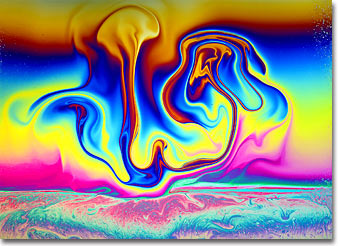Karl E. Deckart
Soap Bubble Gallery: Image Ten
German photographer and artist Karl E. Deckart is known for his thorough, precise, and beautiful work both in photography through the microscope and with macro camera systems. This gallery of interference photographs made with soap films is a testament to both Deckart's skill as a photographer and his understanding of the physical phenomena that surround our everyday lives. Presented below is soap bubble image number ten in small format. Click on the image to download a larger version.

|
Macrophotography of thin soap films freely suspended on a 4 x 4-inch wire frame was conducted with a Linhof large-format bellows camera system utilizing 4 x 5-inch sheet film and imaged using an apo-macro Nikon large format Nikkor-AM ED 210 mm f-5.6 lens. To prepare the soap film, equal parts of water, glycerin, and dishwasher detergent are thoroughly mixed in a container until a solution containing evenly sized micelles is achieved. A freestanding film is formed by dipping the wire frame into the solution and withdrawing carefully to maintain an even film thickness and avoid disruption of material flow across the frame rails. After suspension, the film was illuminated by a reflected light source positioned a few degrees from the camera system. The light was passed through a diffusion screen to avoid bright spots and provide an even illumination across the field. No polarizers were employed in photomacrography of soap thin films. Image ©1999 by Karl E. Deckart. All rights reserved. |
Liquid soap is not a new variety of soap, but was the standard soap produced in homes and farms across America during the colonial years. After the soap mixture cooled, a brown, slippery, jelly-like substance was ladled out of a wooden barrel and stored for later use. A sudsy foam would form when the liquid soap was mixed with water, and this solution was used to wash clothes and for the occasional bath. Although addition of common salt transforms soft soap into a hardened, more easily stored and transported substance, this was rarely done by colonial soap makers. Salt was instead reserved for meeting the mineral requirements of healthy livestock and preserving foods stored for consumption during the winter months. Usually only purveyors of soap would throw salt into the soapy mixture at the end of boiling, often in addition to blending with scented oils such as lavender. The mixture was allowed to cool and harden in wooden crates, after which bars would be cut into chunks and usually sold by the pound.
BACK TO THE SOAP BUBBLE GALLERY
